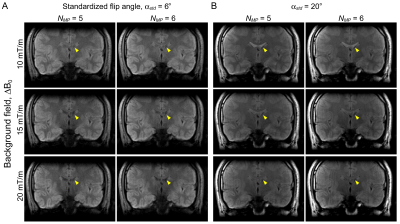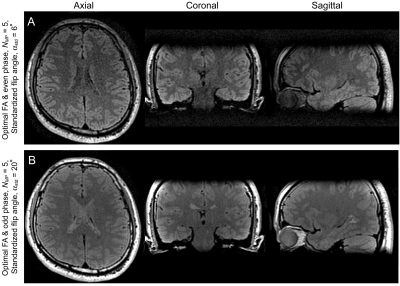0903
Optimization of Flip Angle and RF Pulse Phase in MP-SSFP for MRI in Inhomogeneous Magnetic Fields1CMRR, Radiology, University of Minnesota, Minneapolis, MN, United States
Synopsis
Flip angle and RF pulse phase in 3D MP-SSFP were optimized to maximize SNR. Optimal flip angle and pulse phase were estimated by numerically maximizing the steady-state magnetization in MP-SSFP with SAR penalty. The estimated optimal flip angle and phase were experimentally validated with an agar gel phantom at 3T. The optimal RF pulse setting improved SNR up to 41% under the fixed SAR conditions, depending on MP-SSFP sequence parameters. Finally, in vivo human brain imaging was conducted to demonstrate image contrasts in MP-SSFP images with the optimal flip angle and pulse phase.
Introduction
3D MP-SSFP has recently been introduced as an imaging sequence for use with inhomogeneous magnetic fields1. While MP-SSFP is highly tolerant to the magnetic field inhomogeneity, it requires a broadband excitation RF pulse to cover the widely distributed frequency range over the 3D imaging volume, which limits achievable flip angles (i.e, SNR) due to severe SAR limitations. In this study, we introduce optimal flip angle and RF phase in 3D MP-SSFP to maximize SNR under the SAR limitations.Methods
In MP-SSFP, one RF pulse in every NMP pulses is replaced with an acquisition window to acquire refocused spin- and stimulated echoes, and as such, each repetition period contains NMP-1 RF pulses. To constrain SAR in MP-SSFP, SAR regularization was introduced in the numerical optimization; optimal flip angle, $$$\mathbf\alpha = (\alpha_0, ..., \alpha_{N_{MP}-2})$$$, and RF phase, $$$\mathbf\phi = (\phi_0, ..., \phi_{N_{MP}-2})$$$, were determined by solving the following:$$\mathbf\alpha , \mathbf\phi =arg\min_{\hat{\mathbf\alpha},\hat{\mathbf\phi}}F(\hat{\mathbf\alpha}, \hat{\mathbf\phi})$$,
$$ F(\mathbf\alpha,\mathbf\phi)=-|M_{ss}|+\lambda\alpha_{std}^2$$,
$$ \alpha_{std}=\sqrt{\sum_{i=0}^{N_{MP}-2}\alpha_i^2/N_{MP}}$$,
where Mss is the steady-state transverse magnetization computed with extended phase graph simulation2,3, αstd is the “standardized” flip angle representing RF energy per unit time (αstd2 $$$\propto$$$ SAR) and λ is a regularization parameter to enforce the SAR constraint. The minimization problem was solved with a simplex search method4.
Two types of optimal RF phase $$$\mathbf\phi$$$ were obtained depending on λ: $$$\phi_i=2n\pi\cdot i/N_{MP}$$$ and $$$\phi_i=(2n-1)\pi\cdot i/N_{MP},(^\forall n\in \mathbb{Z})$$$ with strong and weak regularization, respectively. The two phase conditions were referred to as “even” and “odd” phase hereafter. The even and odd optimal phase conditions were consistently observed regardless of the background inhomogeneous field and the missing pulse interval NMP tested in this study (Fig.1A). Optimal flip angle α was set to the solution that provided αstd=6º and 20º for the even and odd phase, respectively (Fig.1B).
MRI studies were conducted with a Siemens Prisma 3T MRI using a 64ch head/neck coil. The optimal flip angle and phase were first tested with an agar gel phantom. Then, in vivo human brain imaging was performed with healthy volunteers under an IRB approved protocol. The MP-SSFP sequence parameters used in MRI experiments (and the optimization of flip angle and phase) were: τ=5 ms, NMP=3-6, αstd=6º and 20º, flattened hyperbolic secant pulse (HS2)5 with 1.6-ms duration and 12 kHz bandwidth and readout bandwidth=46 kHz. A linear inhomogeneous field ΔB0 of 10, 15 or 20 mT/m was turned on during the entire MP-SSFP scan with the z channel of the gradient coil set. The linear inhomogeneous field was partly compensated during excitation and readout by modulating the z gradient amplitude. MP-SSFP scans with a constant flip angle for all RF pulses were conducted for comparison.
Results
With αstd=6º, SNR was 1.02/1.06/1.08/1.14 times higher for NMP = 3/4/5/6 with optimal flip angles than with constant flip angles, which matched well with the simulation results (Fig.2A). As observed in simulation, even RF pulse phase provided higher SNR than odd RF phase in the low flip angle/SAR condition (Fig.2B). With the high flip angle of αstd=20º, optimal flip angles improved SNR by a factor of 1.07/1.41/1.30/1.26 relative to constant flip angles for NMP = 3/4/5/6 (Fig.2C). In the high flip angle/SAR condition, odd RF phase achieved higher SNR than even RF phase (Fig.2D).To demonstrate image contrasts, brain imaging was conducted with optimal flip angle of αstd=6º or 20º and odd or even RF phase (Fig.3). SAR was 5-6% and 50-60% of the limit with the vendor provided SAR monitor for αstd=6º and 20º, respectively. With αstd=6º, although SNR increased along with an increase of NMP, image contrast was similar regardless of RF phase and NMP (Fig.3A). With αstd=20º, odd phase provided stronger contrasts between gray and white matters (Fig.3B). Image contrasts with αstd=20º and even RF phase were mostly T1-weighted. The background inhomogeneous field, ΔB0, tested herein made minimal impact on image contrasts of brain tissues regardless of RF phase, but CSF signal intensities decreased along with an increase of ΔB0 due to its high ADC value (Fig.4). High resolution imaging was performed with the SNR optimal setting for αstd=6º and 20º (Fig.5). While the low flip angle (αstd=6º) achieved stronger image contrasts in brain tissues, SNR was conspicuously higher with αstd=20º than with αstd=6º.
Discussion
The standardized flip angle αstd is an SAR-based function (αstd2 $$$\propto$$$ SAR) such that MP-SSFP scans with a constant αstd entails identical SAR. Therefore, the optimal flip angle and phase herein achieved an up to 41% increase of SNR under the fixed SAR conditions.In previous works1,6, two RF phase settings were introduced: constant and alternate phase. When NMP is odd, the even and odd RF phase from optimization in this study matches constant and alternate RF phase in the previous works, respectively. With NMP = an even number, either constant or alternate RF phase matches the even RF phase such that the two RF phase settings resulted in an identical |Mss| in the previous report1.
Conclusion
Optimal flip angle and RF phase numerically determined in this study improved SNR under the fixed SAR conditions and provided strong image contrasts in brain tissues at 3T.Acknowledgements
This work was supported by NIH grants U01EB025153 and P41EB027061.References
1. Kobayashi N, Parkinson B, Idiyatullin D, Adriany G, Theilenberg S, Juchem C, et al. Development and validation of 3D MP-SSFP to enable MRI in inhomogeneous magnetic fields. Magnetic resonance in medicine. 2021;85(2):831-44. Epub 2020/09/07. doi: 10.1002/mrm.28469. PubMed PMID: 32892400.
2. Scheffler K. A pictorial description of steady-states in rapid magnetic resonance imaging. Concepts in Magnetic Resonance. 1999;11(5):291-304. doi: doi:10.1002/(SICI)1099-0534(1999)11:5<291::AID-CMR2>3.0.CO;2-J.
3. Weigel M. Extended phase graphs: dephasing, RF pulses, and echoes - pure and simple. Journal of magnetic resonance imaging : JMRI. 2015;41(2):266-95. Epub 2014/04/17. doi: 10.1002/jmri.24619. PubMed PMID: 24737382.
4. Lagarias JC, Reeds JA, Wright MH, Wright PE. Convergence properties of the Nelder-Mead simplex method in low dimensions. Siam J Optimiz. 1998;9(1):112-47. doi: Doi 10.1137/S1052623496303470. PubMed PMID: ISI:000077759800001.
5. Garwood M, DelaBarre L. The return of the frequency sweep: designing adiabatic pulses for contemporary NMR. J Magn Reson. 2001;153(2):155-77. Epub 2001/12/13. doi: 10.1006/jmre.2001.2340. PubMed PMID: 11740891.
6. Patz S, Wong STS, Roos MS. Missing pulse steady-state free precession. Magnetic resonance in medicine. 1989;10(2):194-209. doi: doi:10.1002/mrm.1910100205.
Figures




